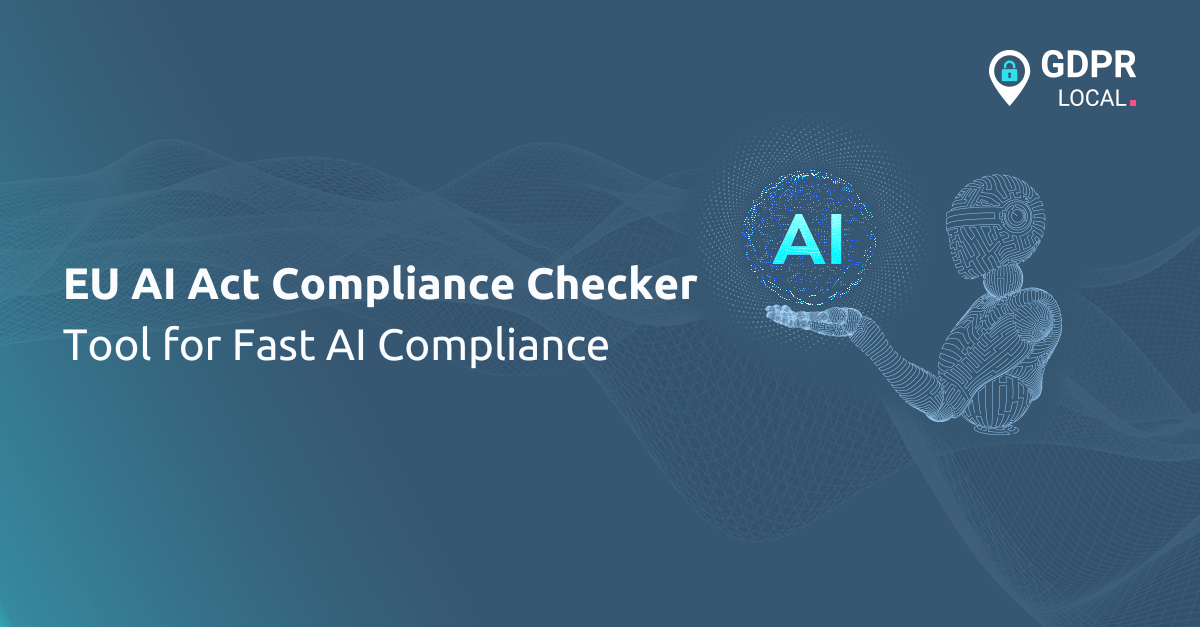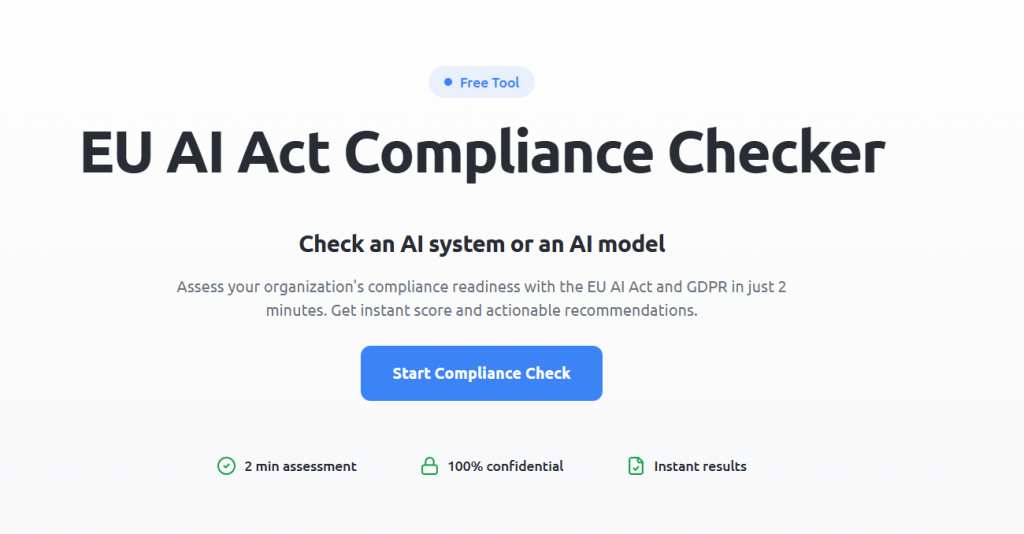
EU AI Act Compliance Checker: GDPRLocal’s New Tool
Introducing the EU AI Act Compliance Checker
We’ve designed the EU AI Act Compliance Checker to clarify the EU AI Act’s obligations and requirements in a practical and accessible manner.
In just 2 minutes, organisations can assess their compliance readiness with both the EU AI Act and GDPR requirements through our AI-powered assessment engine. The tool delivers an instant compliance score and expert-backed, actionable recommendations tailored to your organisation’s specific needs.

Built by our GDPR and AI Act compliance specialists with years of regulatory experience, the Compliance Checker represents an ongoing project that continues to evolve based on user feedback. For questions or insights about the tool, organisations can reach out to [email protected].
Key Features:
• Fast & Accurate: Generate compliance scores in under 2 minutes using AI-powered assessment
• Expert-Backed: Built by our GDPR and AI Act compliance specialists
• Actionable Insights: Receive personalised recommendations specific to your organisation
• 100% Confidential: All data is handled with full confidentiality
The tool works by having organisations assess their AI systems or models, evaluating compliance readiness through structured questions that produce immediate results. This approach allows businesses to identify gaps and receive concrete next steps without requiring weeks of legal review or the involvement of external consultants.
Understanding the EU AI Act: A Risk-Based Framework
The EU Artificial Intelligence Act is the world’s first legal framework specifically designed for artificial intelligence. It came into force on 1 August 2024, with a gradual enforcement timeline, where the majority of provisions begin to apply on 2 August 2026. The Act establishes a unified regulatory framework across the European Union to ensure that AI systems are trustworthy, transparent, and aligned with fundamental rights and democratic values.
AI Risk Classifications
We’ve built our expertise around the AI Act’s risk-based approach, which classifies AI systems into four primary categories based on their potential impact on citizens’ rights and safety:
• Unacceptable Risk (Prohibited): Certain AI systems are banned outright due to posing unacceptable risks to people’s safety, livelihoods, and rights. These include systems that exploit vulnerabilities, manipulate or mislead individuals, manipulate emotions, or use biometric data for social scoring.
• High-Risk Systems: AI systems classified as high-risk must comply with strict requirements, including security, transparency, and quality obligations, and undergo conformity assessments. Examples include AI systems intended for recruitment and selection, law enforcement, critical infrastructure, and essential commercial services. Deployers of high-risk systems must log system activity, establish adequate data management practices, and ensure human oversight capabilities.
• Limited-Risk Systems: These applications are subject to basic transparency requirements. For instance, AI systems that generate artificial content must clearly disclose to users that the content is generated by an AI.
• Minimal-Risk Systems: The majority of AI tools, such as chatbots and spam filters, are considered low-risk and are not subject to regulatory restrictions, though organisations are expected to operate responsibly.
How the AI Act Complements GDPR
The EU AI Act does not replace GDPR requirements; it complements them. Both regulations apply to many organisations, particularly those that deploy AI systems to process personal data.
The GDPR focuses on protecting the fundamental right to privacy, giving individuals the power to enforce their rights against those who process their personal data. The AI Act takes a product-regulation approach, aiming to regulate AI systems through product standards and safety measures.
In practice, this means:
• During AI development, providers processing personal data are generally considered data controllers under GDPR
• During deployment, organisations using AI systems involving personal data are typically data controllers
• High-risk AI systems processing personal data must comply with both AI Act requirements (conformity assessment, documentation, human oversight) and GDPR obligations (lawful processing, consent, data subject rights)
Meeting AI Act compliance requirements can actually support and streamline GDPR compliance efforts by establishing transparent, well-documented AI governance practices. Organisations that implement robust data management and transparency practices for AI Act compliance simultaneously strengthen their GDPR posture.
The Role of AI Literacy in Compliance
While technical compliance with the EU AI Act is essential, organisational compliance also depends on human understanding and the responsible use of AI. AI literacy, the ability to understand how AI systems work, their limitations, and their risks, is fundamental to ensuring that AI systems are used safely, ethically, and in accordance with regulatory requirements.
We emphasise that AI literacy extends beyond technical teams to every employee who interacts with AI tools. Generative AI tools, such as ChatGPT, Google Gemini, and Microsoft Copilot, are becoming increasingly common assistants across all professional domains and industries. While these tools offer significant advantages, employees must be aware of the associated security risks, data protection considerations, and the appropriate use cases.
Organisations can establish clear, organisation-wide AI usage guidelines through our AI Literacy Policy, which provides teams, contractors, and departments with simple rules for using AI tools responsibly. An effective AI literacy policy outlines which AI tools and use cases are appropriate, and which are not, so that everyone understands the ground rules. This ensures that organisations not only comply with regulatory requirements but also build a culture of responsible, secure, and ethical AI usage.
Moving Forward
The full enforcement of the EU AI Act is expected by the end of 2027. Organisations that begin preparing now, by understanding their AI system classifications, assessing compliance readiness, and establishing governance practices, position themselves to adapt smoothly to regulatory requirements rather than face compliance gaps at the deadline.
Our EU AI Act Compliance Checker provides a clear starting point for this journey, offering insight into the current compliance status and concrete recommendations for next steps. Combined with robust GDPR practices and organisation-wide AI literacy initiatives, businesses can build sustainable compliance frameworks that support both regulatory adherence and responsible AI innovation.
Important Disclaimer
The results generated by the Compliance Checker are for informational purposes only. They are not considered legal advice, and organisations are encouraged to seek assistance from a legal professional for tailored advice specific to their situation. The results represent an assessment based on the information provided and do not constitute a full compliance determination.